Content
- Views
- Refractive
- Dysbinocular
- Obscuration
- Anisometropic
- Hysterical
- Stages and degrees
- Weak
- Average
- High
- Very high
- Symptoms and Signs
- Causes
- Diagnostics
- Treatment methods
- Gymnastics for the eyes
- Occlusion
- Physiotherapy
- Penalization
- Sphero-prismatic Fresnel glasses
- Surgical intervention
- Spectacle optics
- Medications
- Possible consequences and complications
- Video about amblyopia
Lazy eye (amblyopia) Is a syndrome of lowered vision caused by functional disorders of the optic nerve. This condition poses the greatest danger to children, as it can affect the ability to perceive information, learn and adapt in society. A photo of the disease and its full description can be viewed in the article.
Views
The "lazy" eye in children is divided into several types. The classification depends on the cause of the onset of the disease.
Refractive
Refractive amblyopia is a common childhood disease in the field of ophthalmology. A characteristic feature is the gradual disorder of the eye, which is combined with other pathologies of the visual apparatus, as well as the distortion of the shape of the contour of the object during its study.
Against the background of refractive amblyopia, aggravated forms of the following diseases also develop:
- hyperopia;
- severe myopia;
- astigmatism.
Modern methods of treatment and diagnostics make it possible to determine the disease in time and begin therapy, and restore the focus of vision.
Dysbinocular
Dysbinocular amblyopia is a type of disease that is a unilateral type of strabismus. As a result of prolonged amblyopia, the brain gradually does not receive signals from the diseased eye.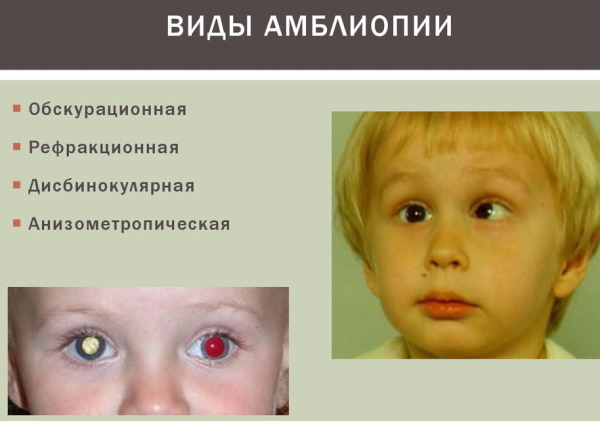
To exclude the possibility of complete interruption of signals from the retina to the cerebral cortex, it is necessary to carry out diagnostics in time. Otherwise, strabismus caused by dysbinocular amblyopia will be exacerbated by the emerging lazy eye syndrome.
Obscuration
Obscuration amblyopia is a disease that occurs against the background of damage to the eye.
The most common causes of the disease are:
- cataract;
- clouding of the cornea;
- mechanical damage.
A factor in the development of the lazy eye syndrome is the functional inability of the organs of vision to normal work. This leads to a delay in the development of the system of nerve centers, receptors and connecting pathways between the brain and the visual organ.
Anisometropic
Anisometropic amblyopia is established when the refractive power of the left and right eyes differ from each other. As a result of this type of amblyopia, a person cannot form a single visual image.
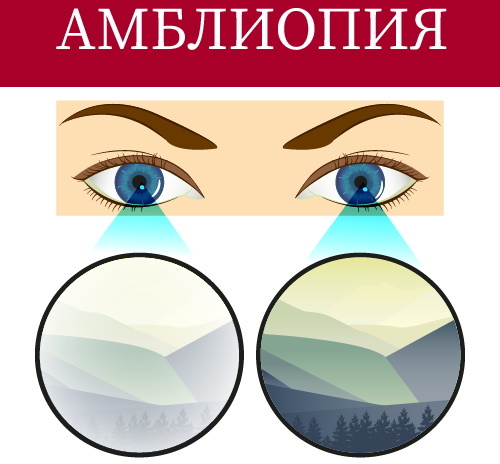
The eye with the least visual acuity is removed from the central nervous system.
Hysterical
Hysterical amblyopia is a disease caused by psychopathological disorders against the background of historical neuroses. One of the factors in the development of the disease is the decompensation of hysterical psychopathy against the background of imaginary, inorganic blindness.
Stages and degrees
Lazy eye syndrome is divided into several degrees. The classification depends on the level of visual acuity. Visual acuity is an indicator of the ability of the visual organ to separate 2 points separately with a minimum distance between them.
Weak
Weak amblyopia is a disease in which visual acuity decreases to 0.4-0.8.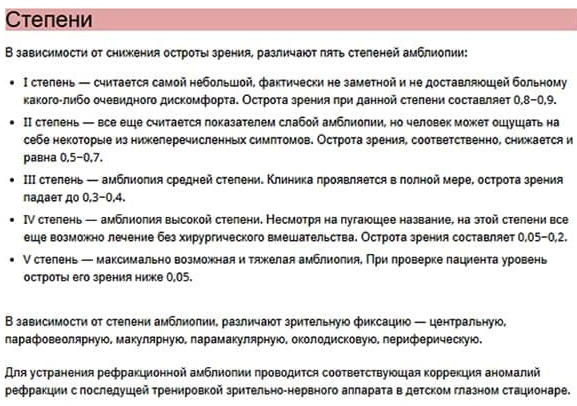 In this case, mild symptoms are noted.
In this case, mild symptoms are noted.
Average
Medium amblyopia is a condition in which the visual acuity of the affected eye ranges from 0.2 to 0.3 units. This type of syndrome is characterized by more pronounced symptoms.
High
A high degree of amblyopia is considered with visual acuity indices in the range of 0.05-0.1. With high degrees of the disease, the likelihood of developing strabismus and visual impairment is increased.
Very high
A very high degree of amblyopia is a disease in which visual acuity varies by up to 0.04. With this type of disease, the development of pathologies of the visual organ is most likely.
Symptoms and Signs
Lazy eye in children in 70% of cases is of the dysbinocular type.
This disease is characterized by the following symptoms:
- reduced vision for 1 or 2 visual organs. A distinctive feature is the absence of changes in the quality of vision when correcting with glasses;
- characteristic symptoms for children are the inability or deterioration of the assimilation of visual information;
- violation of the visual perception of the object. Problems in the definition of spatial features (location of quantities and size, shapes) can be noted;
- the presence of strabismus. The symptoms of the disease intensify, the asymmetrical arrangement of the corneas, outer and inner corners of the eyelid becomes more noticeable.
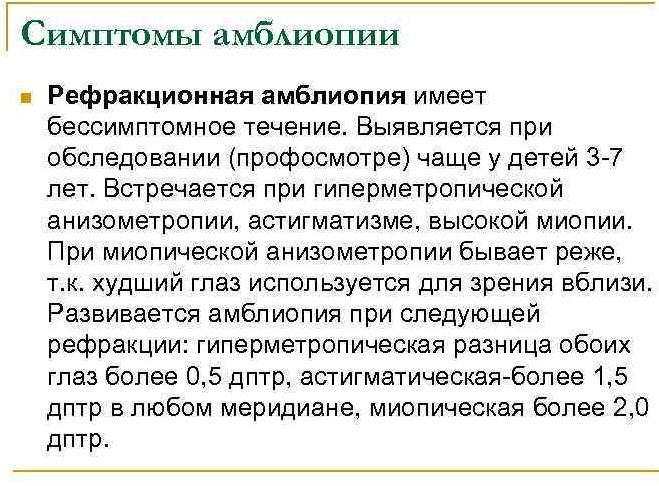
It is quite difficult to notice the symptoms of amblyopia, especially if the disease is mild. The clinical picture at this stage is absent, and only a specialist is able to determine the presence of signs.
Causes
Lazy eye in children is a condition that can be caused by other developmental disorders.
Risk factors that can cause the development of amblyopia include:
- constant or periodic deviation of the visual axis from the fixation point, impairment of binocular vision;
- inability to focus on objects located in the distance;
- violation of the spherical shape of the cornea;
- mechanical trauma to the eye and previous operations on the retina;
- movement disorders that result from brain damage (during the perinatal period);
- congenital disorders of the body, heredity;
- poor transmission of visual data to the retina, the impossibility of adapting the organs of vision to the intensity of illumination;
- changed shape of the lens;
- violations in the selection of spectacle optics, incorrect spectacle vision correction;
- psychosis, hysterical states, stress.
Lazy eye syndrome can occur in children with abnormal intrauterine development. Common risk factors for the onset of amblyopia are weight deficiency, prematurity, taking alcohol and smoking, drugs and drugs (contraindicated for pregnant women) during pregnancy.
Diagnostics
It is quite difficult to diagnose a lazy eye, especially with a mild degree of the disease.
To detect the disease, the following measures are taken: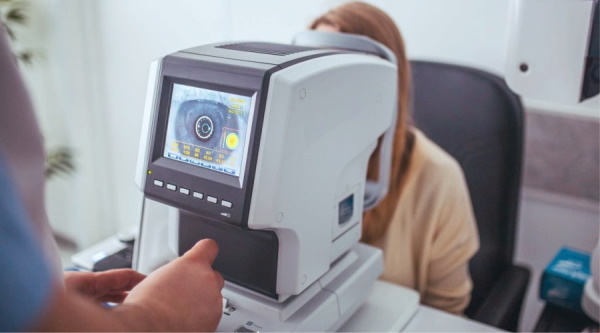
| Method | Description |
| Taking anamnesis | Before starting the procedure, it is necessary to determine the transfer of infectious or viral diseases. It is also required to interview the parents of the child about the condition of the fetus during pregnancy. Is it possible to take alcohol, drugs, medications or suffer serious illnesses while carrying a fetus. |
| Inspection, determination of strabismus | Strabismus can be one of the risk factors for amblyopia. Visually, you can determine a slight deviation of the organs of vision. |
| Determination of the indicator of visual acuity using a special table | The procedure is most often carried out by children 5-6 years old. The process includes a sequential examination of each character in the table (from the topmost row to the bottommost). The quality of vision increases with the number of visible objects. In this case, it is necessary to alternately close one or the other eye in order to determine the presence of a disease on all organs of vision. The diseased eye is characterized by the impossibility of identifying objects. |
| Ultrasound examination of the eyeball | The procedure allows you to determine all indicators of the organ of vision, as well as the shape of the eyeball and the presence of visual defects associated with the shape of the cornea. |
| Autorefractometry of the eye | A procedure to determine the clarity of rendered distant objects. With the help of this device, which shows accurate indicators, it is possible to determine the type of visual impairment and the severity of the pathology. |
| Fundus examination | A procedure in which medications are used. With the help of medications, the accommodation of the pupil is disturbed (with the aim of expanding it). Then, using special lamps, the fundus is examined. During the process, the specialist can determine the state of all intraocular elements. With amblyopia, damage to the retina or optic nerve is possible. |
| Determination of the development of lateral vision using the ophthalmic perimeter | The device sets a certain image to a separate eye, after which it starts moving. Moving from the periphery to the center, the examined person catches the movement, and then inform the doctor. After the procedure, an assessment is carried out. With strabismus, a complete violation of lateral vision is possible. |
| Determination of the angle of strabismus using ophthalmic devices | A separate test is performed for each eye, with the help of which the doctor determines the rate of deviation from the normal orbit. The higher the indicator, the worse the patient's condition and the more severe the degree of the disease. |
| Color test | The color test allows you to determine the presence of amblyopia, as with lazy eye syndrome, color vision may be impaired. During the procedure, the specialist shows the child circles of different colors, inside which are numbers or letters. In a normal state, the child must identify all the colors and symbols that are inside the figure. |
| Biomicroscopy | Determination of the cellular composition of the outer surface of the eyes. At the same time, tissue sampling is not performed, which allows for an intravital procedure. |
With the help of a comprehensive diagnosis, it is possible to determine the presence of amblyopia, as well as the severity of the disease and its type. After determining, you can start treatment, or conduct additional consultations with doctors of a narrow specialty.
Treatment methods
Lazy eye in children is an ophthalmic disease that can be treated at home. Therapy includes optical correction, occlusion (transfer of increased load on the sore eye, a healthy eye is closed), pleoptics and penalization (creating artificial conditions to reduce the severity healthy eye).
Gymnastics for the eyes
Eye gymnastics is a simple and affordable way to activate the work of the oculomotor muscles.
To get the result, you need to do the exercises every day:
- Turn the eyes clockwise and in the opposite direction.
- Draw numbers with your eyes, ranging from 1 to 9 units. Then draw the infinity symbol.
- Make turns up and down and left and right with the eyeballs.
- Blink for 30 seconds, perform almost continuously.
- Squinting and relaxing the eyelids.
- Consideration of near and far elements.
The set of exercises is designed for 5-7 minutes. Optionally, you can add additional elements after prior consultation with a specialist.
Occlusion
Occlusion is a method of treating amblyopia in children in the early stages. It consists in placing a special bandage on the strong eye - an occluder.
An occluder is a bandage that covers one of the lenses on your glasses. Since the strong side cannot function, the entire burden is transferred to the weak side. In modern spectacle optics, a special device is used - selective glasses. To help children in the fight against complexes, they develop bright designs of occluders, with drawn cartoon characters.
Physiotherapy
Physiotherapy is a method that promotes better absorption of vitamins as well as responsiveness to treatment.
The following are used as physiotherapeutic methods:
- massage is a manual technique of mechanical and reflex action on human tissues and organs;
- electrophoresis - a procedure in which the human body is subjected to constant electrical impulses to provide a therapeutic effect;
- magnetotherapy - a type of alternative therapy that works by exposing tissues and organs to a magnetic field;
- electrotherapy.
Physiotherapy is not used as the only method of treatment, but only in combination.
Penalization
Penalization is a technique that suppresses the function of a healthy visual organ. For the implementation of the method, hypercorrecting glasses and drops with atropine (to expand the fundus) are used.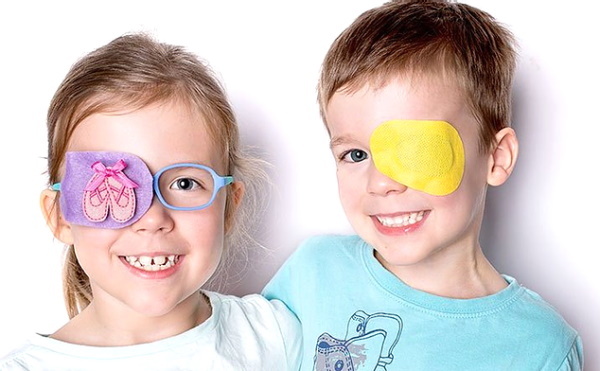
The essence of the method is to reduce the function of a healthy organ. Due to the effect on the nerve endings, the brain does not feel the need to turn off the functions of the affected organ.
Sphero-prismatic Fresnel glasses
Sphero-prismatic Fresnel glasses are a device that allows you to restore binocular vision. Due to the use of special spectacle optics, the state of the visual apparatus is achieved, in which the eyeballs are located on the central axes.
The peculiarity of Fresnel glasses is that they can be used by children from 3 years old, which makes it possible to correct the syndrome of the "lazy" eye of the congenital type. A special device acts quickly enough to restore the normal position of the eyeballs and stimulate the oculomotor muscles.
Surgical intervention
Surgery is a rather dangerous type of treatment, which is prescribed only in cases where the disease cannot be treated in other ways. There are 2 types of operations: weakening and amplifying. The exact view is established by a specialist after a thorough diagnosis.
The procedure is designed for 1-1.5 hours. In this case, local anesthesia is performed. The procedure has a positive effect, which must be supported by gymnastics and physiotherapy methods.
Spectacle optics
Corrective optics involves wearing glasses or special lenses. The devices must be worn throughout the day, taking them off only for sleep.
For eyeglass optics of a child, the following rules are established:
- glasses should be light so that during the day the child does not feel discomfort;
- it is necessary to select optics only with a doctor, after conducting appropriate tests;
- to keep the optics in working order, it is necessary to purchase auxiliary elements, as well as instruct on the use and storage.
For children, in most cases, glasses are a convenient and safe method. The doctor writes out a prescription, according to which it is necessary to purchase a device made of special glass.
Medications
In the treatment of eye diseases, medications are prescribed that maintain the condition of the eyes by moisturizing.
The most commonly used drugs are:
| A drug | the effect | Mode of application | Contraindications |
| Comfort Drops | The purpose of use is to moisturize the eyes. Can be used when using contact lenses. | 1-2 drops in each eye. If used in combination with lenses, first apply 1-2 drops to the lens. | Not recommended for people with hypersensitivity. |
| ReNu MultiPlus | It is used to moisturize the surface of the eyes, as well as when using contact lenses. The solution allows you to make the wearing of spectacle optics comfortable. | ||
| Likontin Comfort | Makes it easier to wear contact lenses. | 1-2 drops in each eye - as a moisturizer. For contact lenses - an additional 2 drops for each lens. | Hypersensitivity to the composition of drops. |
| Opti-Free Moisturizers | Moisturizing drops that can be used in combination with contact lenses. | 1 drop in each eye, then blink 2-3 times. | Hypersensitivity to the components of the drug. |
| Systain Ultra Plus | Moisturizing the surface of the eyes. | 1-2 drops in each eye. Can be used throughout the day as needed. | Allergic reactions to substances of the composition. |
The most effective drug is selected by the doctor, based on the type and degree of the disease.
Possible consequences and complications
Lazy eye is a treatable disease. In the absence of timely therapy, children may experience a complete loss of binocular vision. The prognosis directly depends on the type and degree of the disease. The simplest treatment is obscuration amblyopia.
"Lazy" eye is a syndrome of lowered vision associated with a functional disorder of the visual analyzer. The disease can manifest itself in both children and adults. The disease in the early stages is easily treatable, therefore, as a preventive measure, it is necessary to carry out regular examinations.
Video about amblyopia
Amblyopia or lazy eye:



